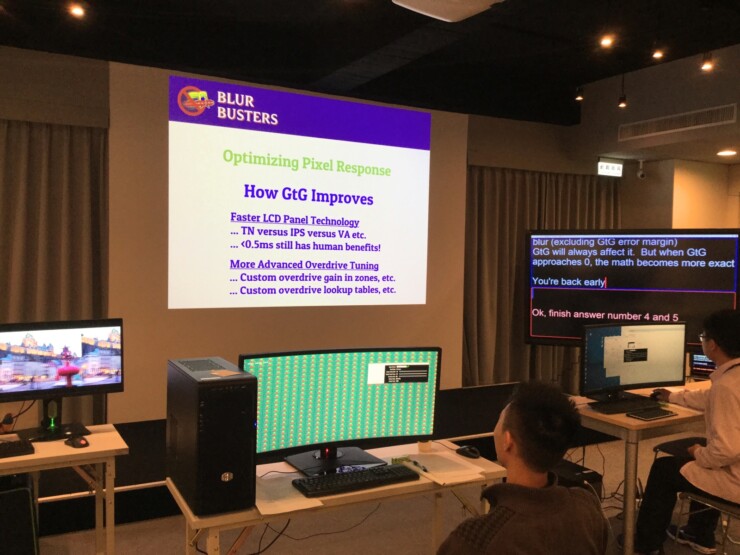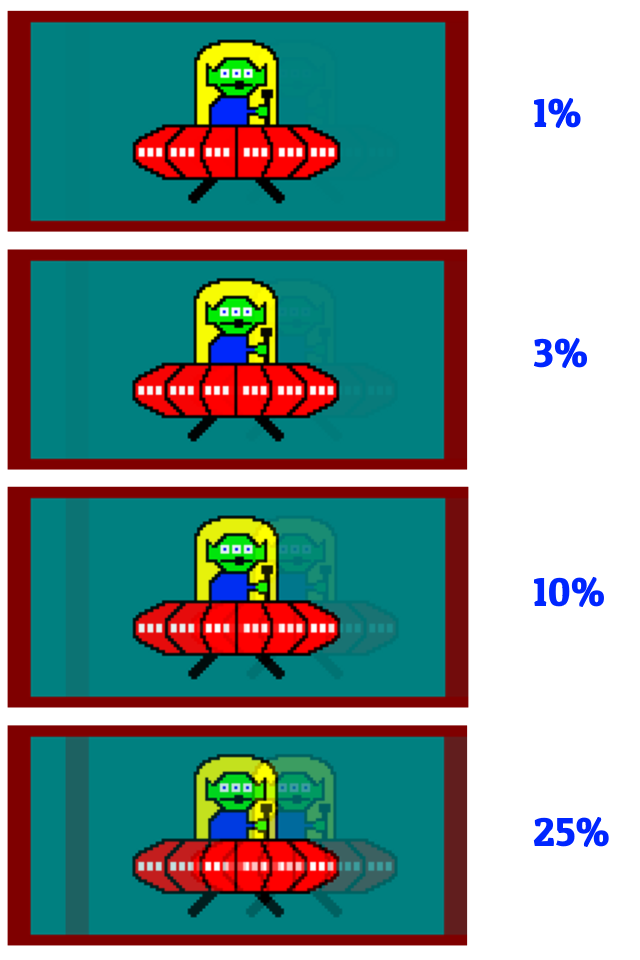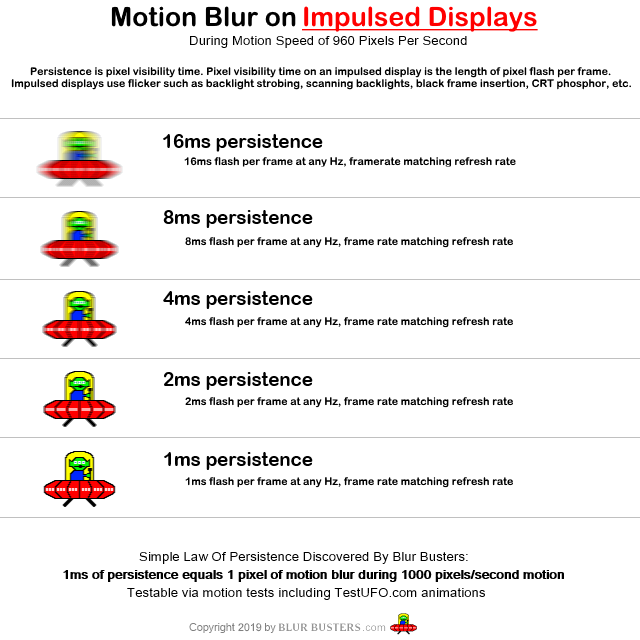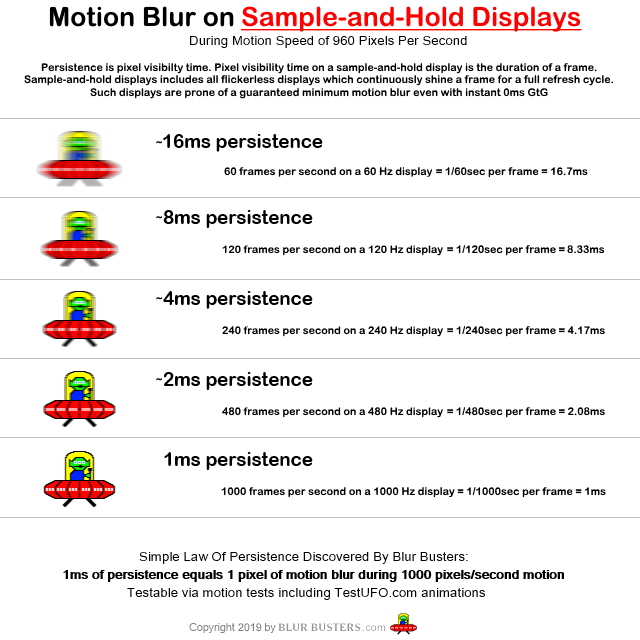Oh, I teach master classes at display manuacturers now.

For some of the textbook education simplified to an easy "Popular Science" or "Coles Notes" format, see:
Blur Busters Area 51: Textbook Reading on Blur Busters Website
This is educational to CRT-era people only discovering that 1% of the best LCDs can now beat CRTs in motion resolution.
("Motion resolution" is fine. Just use "MPRT" or more modern benchmarks, not "lines of")
(Alas, large LCDs don't yet strobe crosstalklessly at large sizes yet, unless you're doing the 120Hz->60Hz QFT trick to refresh-headroomize it and get low-crosstalk 60Hz on a 120Hz LCD scanning out 60Hz refresh cycles in 1/120sec to create 8ms of VBI total darkness to hide pokey slow LCD GtG from human eyes -- good strobing headroom requires complete GtG100% hide)
We are Blur Busters. This is our specialty. To put it succinctly, we know this shit.

NeonPizza wrote: ↑20 Oct 2021, 13:09
Also, regardless of the Q90A QLED being sample & Hold like the LG C1 OLED, due to the Q90A's slower motion response time, wouldn't there still be more motion blur/smearing?
Measuring pixel response during strobing is different.
The game of LCD strobing is to try to hide LCD GtG in the blanking interval, to hide slow pixel response from human eyes.
Even an 8ms LCD can strobe better than a CRT, if it's 8ms GtG 100%, and the 8ms is occuring while the backlight is turned off.
Benchmarks on LCDs need to be done separately in non-strobed operation (fully visible pixel response) and strobed operation (partially visible or invisible pixel response).
See high speed video of LightBoost how strobing can sometimes hide LCD GtG:
Notice how most of the LCD pixel response is hidden from human eyes?
The problem is strobing is sometimes done very badly, some of the explanations is explained at
Electronics Hacking: Creating a Strobe Backlight, a FAQ I wrote in year 2013 in the early days of Blur Busters.
Now, crosstalk of strobing is simply a function of how much LCD GtG is hidden in total darkness between refresh cycles. Here's example artifacts from percentages of incompletely hidden GtG:

Most terrible strobe backlights only hide 75% of GtG, leaving 25% to be human visible.
But the best strobe backlights can hide GtG 99% or 99.5% or 99.9%, especially when combined with the
refresh rate headroom trick to create giant VBI's that you can drive truck through, to hide LCD GtG better between refresh cycles. A 60Hz refresh cycle scanning-out in 1/240sec (4ms) allows up to about 12-13ms of dark time between strobe flashes, more time to hide LCD GtG between refresh cycles.
So even if LCD is 8ms GtG, your eyes only sees 0.5ms MPRT.
Remember GtG and MPRT are different.
GtG = time that a pixel takes to change color (pixel fading from one color to the next)
MPRT = time that a pixel is visible for (visible to eyes).
See
Pixel Response FAQ: Two Pixel Response Benchmarks: GtG versus MPRT
The bonus is GtG can be made invisible to eyes if all of LCD GtG is 100% occuring while the backlight is turned off. Only a few LCDs manage to do this perfectly.
MPRT is what you should be worried about, GtG can be hidden by a good strobe backlight sometimes, the problem is not all strobe backlights are good, and GtG just needs to be improved to be fast enough to finish in the VBI (blanking interval between refresh cycles).
Also, there is a law of physics issue called Talbot-Plateau Law that favours LCD. You need to strobe brighter to strobe briefer. That makes it easier to keep image bright at low MPRTs. OLEDs currently have a hard time doing this. Some LCDs such as XL2546 strobe at 1000-2000 nits to allow it to average ~350 nits. OLEDs have a hard time doing BFI strobe brighter to allow reductions of motion blur.
I love OLEDs but I am cognizant of some of the realities and practicalities that caused the best cherrypicked 1% LCDs to have less motion blur than CRTs (such as the superlative VR LCDs released by Valve and Oculus).
Randomly buying an LCD is always going to be crappy, so one has to carefully shop for the best LCD strobing *and* then do a few additional tricks to reduce strobe crosstalk (e.g. refresh rate headroom).
Tomorrow, the ultimate ergonomic comfort later this century is blurless sample-and-hold, because MPRT(100%) can never be less than one refresh cycle on a sample and hold display. But at 1000fps 1000Hz, the MPRT becomes 1ms. So you have flicker-free CRT motion clarity sample and hold! So that's why we're huge fans of blurless sample-and-hold.


Sadly, you cannot get better than 4ms MPRT with the best LG OLEDs configured with BFI enabled.
Note: refresh rate headroom trick isn't necessary for OLEDs, like it is for LCDs.
(For 60Hz mode, not 120Hz mode)
Unfortunately the 60Hz BFI feature of LG C1 OLED is blurrier than the BFI feature in LG CX OLED.
LG CX OLED BFI Maximum = ~4ms MPRT = 75% less motion blur sample-hold 60Hz
LG C1 OLED BFI Maximum = ~8ms MPRT = 50% less blur than sample-hold 60Hz
In comparision, at 0.3ms MPRT both the Valve Index VR LCD as well as the Oculus Quest 2 VR LCD -- these headset has a perfectly-measured 98.3% less motion blur than a sample-and-hold 60Hz OLED with BFI disabled calculated as (1.0 - (0.3 / 16.7)).
0.3ms MPRT = 0.3 pixels of blur per 1000 pixels/sec panning
16.7ms MPRT = 16.7 pixels blur per 1000 pixels/sec panning
Even with BFI enabled, Quest 2 still has more than 10x less motion blur than the best LG CX OLED (0.3ms vs 4ms MPRT), and more than 20x less motion blur than your LG C1 OLED (0.3ms vs 8ms MPRT). I'm sorry to be the bearer of bad OLED news from a motion resolution perspective. That said, they are much cleaner in ghosting/coronas/pixel response.
However, things magically change with the world's best-strobe-tuned LCDs when all the LCD pixel garbage is completely hidden in dark. There's a 16.7ms time-budget for hiding LCD GtG at 60Hz. If you strobe at only 0.3ms, there's still 16.4ms of darkness to hide LCD GtG. You do have to hide LCD scanout (
high speed videos of LCD scanout), so that's why I use the refresh rate headroom trick, to speed this part up, e.g. 60Hz refresh cycles scanned out in 1/240sec. Then you've got 3/4ths of 1/60sec to wait-out slow LCD GtG in total darkness. If you can hide 100% of LCD GtG artifacts in total darkness, or at least 99.9% (pushing artifacts below human visible noisefloor) for all pixel color combinations on the entire GtG heatmap -- then the 0.3ms MPRT shows perfectly better-than-CRT 0.3ms. Like the VR LCDs.
Strobe benchmarks are totally different from visible-GtG benchmarks, because strobe is a just a mere game of hiding GtG -- and sometimes it's done badly, and sometimes it's done virtually perfectly (the 1% cream of crop LCDs). The theoretical clarity of LCDs is now infinite once GtG100% is perfectly hidden in VBI. This happened recently, and the limitation of motion clarity of LCDs is merely simply how brightly & briefly the backlight can be flashed. One can even use a water-cooled backlight to strobe 10,000 nits for 0.1ms, to even be better than short-persistence phosphor CRTs, which still has green-phosphor ghosting on blacks, which the top 1% strobed LCDs do not have. It's very hard still, but the entire real world GtG-100% heatmap (65280 pixel color combos in 8-bit, excluding the no-operation changes, 65536-256) finally became perfect below human visible error margins on
certain best-1% strobed LCDs. When used with refresh rate headroom and QFT tricks, LCD GtG finally sped up recently to be successfully hidden in VBI, which was the magical thing allowing LCDs to have unbounded motion clarity ability (beating CRTs in motion resolution).


